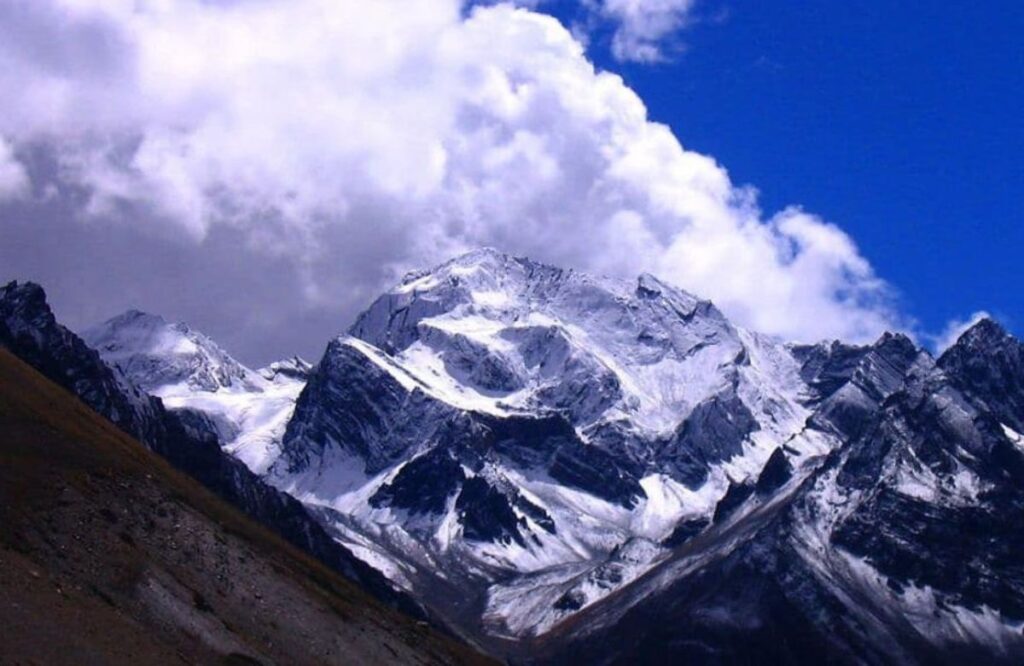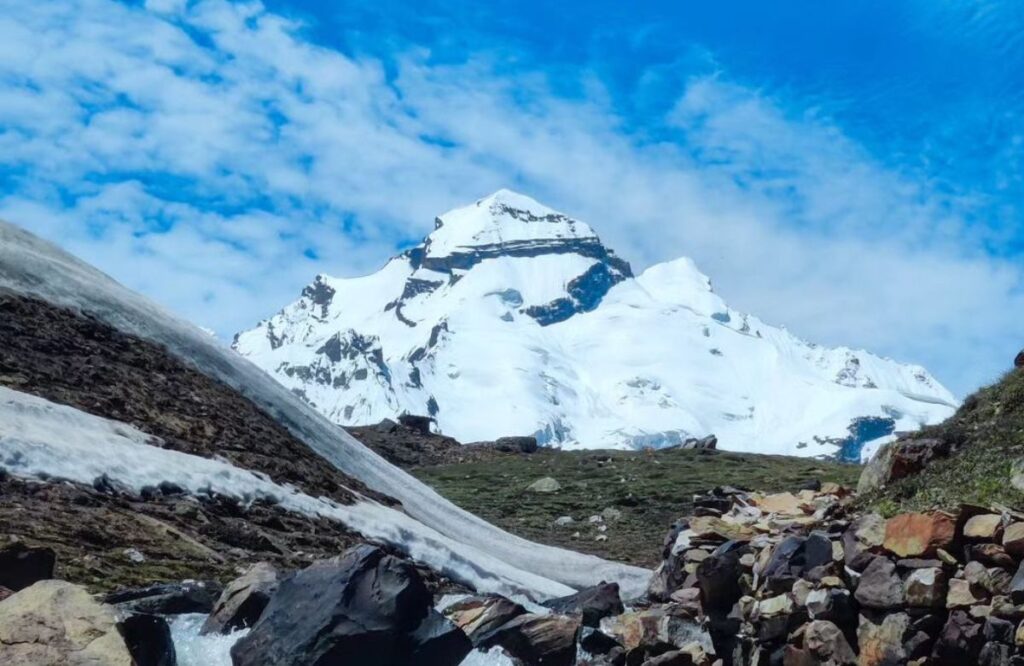Om Parvat holds great religious significance, particularly for Hindus. The mountain is named after the sacred Hindu symbol “Om,” which is naturally formed by the deposition of snow on its rocky surface. Pilgrims embark on challenging journeys to witness the secrets of Om Parvat, and the surrounding region is dotted with numerous other religious sites, including lakes and caves believed to be associated with Hindu mythology.
Where is Om Parvat located?
Om Parvat is located in the Dharchula, Pithoragarh district of the Kumaon region in Uttarakhand, near the Indo-Tibetan border. The exact coordinates of Om Parvat are approximately 30.7364° N latitude and 80.0885° E longitude. The mountain is part of the Great Himalayan Range and holds significant religious importance, particularly in Hinduism.
Pilgrims and trekkers often visit this remote and spiritually significant location to witness the awe-inspiring beauty of Om Parvat.
How to reach Om Parvat?
Reaching Om Parvat involves a challenging and adventurous journey, and it requires careful planning and preparation.
Here is a general overview of how one can reach Om Parvat:
Reach Dharchula:
- Start your journey by reaching Dharchula, Pithoragarh in Uttarakhand state.
- You can travel to Darchula by road from Delhi, Haldwani, or other major cities. The road journey may involve multiple modes of transportation, including buses and jeeps.
Dharchula to Gunji/Nabidhang
- The base camp for Om Parvat is called Nabhidhang, situated at an elevation of around 3,610 meters.
- From Nabhidhang, you can get a clear view of Om Parvat and its distinctive “Om” formation.
Om Parvat story [Kailash Om Parvat]
The name “Om Parvat” is indeed derived from the sacred symbol “Om” in Hinduism, which holds profound philosophical significance. The symbol “Om” represents the cosmic sound and encompasses the essence of the ultimate reality. Each component of the Om symbol – ‘A,’ ‘U,’ ‘M,’ and the dot – carries symbolic meaning, as you rightly mentioned.
The ‘A’ represents the waking state of consciousness, ‘U’ represents the dreaming state, and ‘M’ represents the state of deep sleep. Together, they symbolize the entire spectrum of human consciousness. The dot above the crescent in the Om symbol signifies the fourth state, which transcends the three states of consciousness and represents pure consciousness or the ultimate reality. This dot is often associated with Turiya, the state of absolute consciousness or enlightenment.
Om Parvat, with its natural formation of the Om symbol on its surface, is considered a divine manifestation of this sacred sound and its profound philosophical implications. Pilgrims and spiritual seekers are drawn to Om Parvat not only for its awe-inspiring physical presence but also for the deeper spiritual symbolism it holds, representing the journey from the material world to the realm of pure consciousness.
Importance of Om (ॐ) Parvat
Om Parvat is deeply revered in Hinduism, particularly for its association with Lord Shiva. Lord Shiva holds a significant place in Hindu theology as the Supreme Being, responsible for creation, preservation, and destruction. As the destroyer of evil and ignorance, Shiva is regarded as the source of ultimate knowledge, wisdom, and cosmic balance.
Om Parvat is considered a manifestation of Lord Shiva’s divine power and grace, and it is believed to be a place where devotees can experience the presence and blessings of the deity. The natural occurrence of the sacred symbol “Om” on the mountain is seen as a divine sign, reinforcing its sanctity. Pilgrims undertaking the challenging journey to Om Parvat seek spiritual enlightenment and divine connection with Lord Shiva.
Shiva’s association with meditation and yoga further enhances the significance of Om Parvat as a spiritual destination. The mountainous terrain and the arduous trek serve as a symbolic journey, reflecting the challenges and dedication required to pursue spiritual growth and union with the divine.
For Hindus, Om Parvat stands as a symbol of devotion, a sacred site where the earthly and the divine converge, allowing seekers to immerse themselves in the transcendental energy associated with Lord Shiva. The pilgrimage to Om Parvat is a profound spiritual endeavor, reflecting the deep-rooted faith and reverence for the cosmic principles represented by Lord Shiva in Hinduism.
Om Parvat Weather and Temperature
The weather and temperature around Om Parvat are influenced by its high-altitude location in the Himalayan region. Om Parvat experiences distinct seasons, and conditions can vary significantly based on the time of year.
- Spring (March to May):
- Spring is one of the more favorable times to visit Om Parvat. During this season, temperatures gradually rise, and the weather is relatively mild.
- Daytime temperatures can range from around 5°C to 15°C (41°F to 59°F), making it more comfortable for trekking and pilgrimage.
- Summer (June to August):
- Summer in Om Parvat brings warmer temperatures during the day, with daytime highs ranging between 10°C and 20°C (50°F to 68°F).
- However, this season is also characterized by the monsoon, bringing heavy rainfall, which can pose challenges for trekking due to slippery trails and the risk of landslides.
- Autumn (September to November):
- Autumn is another popular time to visit Om Parvat. The weather is generally clear, and the temperatures begin to drop as winter approaches.
- Daytime temperatures can vary between 5°C and 15°C (41°F to 59°F), and the skies are often clear, providing excellent visibility.
- Winter (December to February):
- Winter in Om Parvat is harsh, with extremely cold temperatures and the possibility of heavy snowfall.
- Daytime temperatures can range from -5°C to 5°C (23°F to 41°F), and nighttime temperatures can plummet below freezing, requiring adequate cold-weather gear for those venturing into the region.
Visitors need to be well-prepared for the challenging weather conditions, especially during winter and monsoon seasons. Trekkers and pilgrims should bring appropriate clothing, and gear, and be aware of the potential for altitude-related issues. Checking weather forecasts and local conditions before embarking on a journey to Om Parvat is essential for a safe and enjoyable experience.
Om Parvat Height and Elevation
Om Parvat a mountain located in Pithoragarh district, Uttarakhand, India Om Parvat’s peak elevation is 5,590 m (18,340 ft) above sea level.
The best time to visit Om Parvat
The best time to visit Om Parvat is during the spring and autumn months when the weather is relatively favorable for trekking and pilgrimage. The recommended periods are May, June, and September to November.
It’s important to note that while summer (June to August) might have milder temperatures, it is also the monsoon season, bringing heavy rainfall and potentially making trekking trails challenging and risky due to slippery conditions and landslides.
Winter (December to February) can be extremely cold, with sub-zero temperatures and heavy snowfall, making it less suitable for most visitors.
Before planning a visit to Om Parvat, it’s advisable to check local weather conditions, obtain necessary permits, and be aware of any travel advisories to ensure a safe and enjoyable pilgrimage or trekking experience in this sacred Himalayan region.


